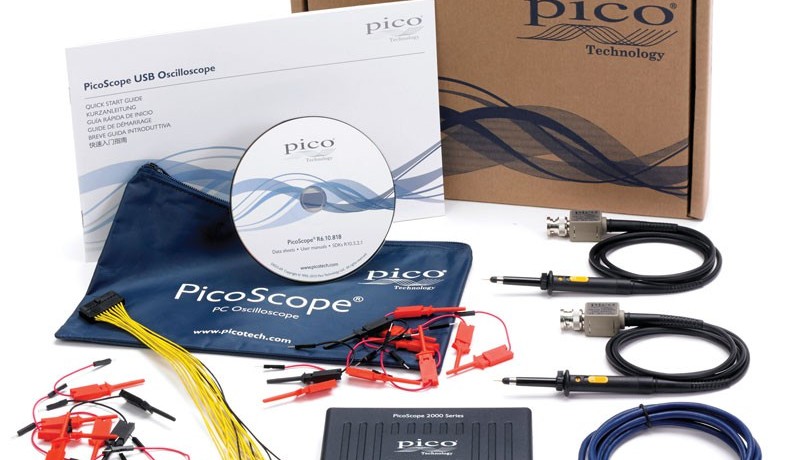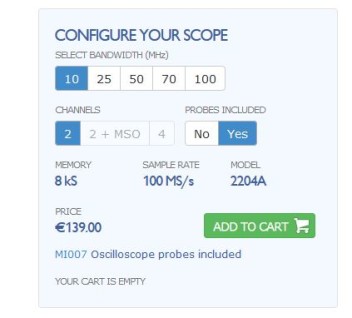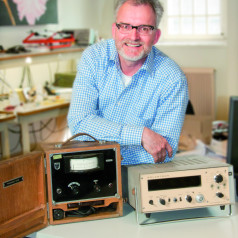Review: PicoScope 2208B-MSO USB Oscilloscope
August 16, 2018
on
on

Pico Technology’s 2000 series USB oscilloscopes have a fine “bandwidth” both in terms of “megahertz” and cost: from the £99 10 MHz entry-level 2204A with 8 kS (kilosamples) memory and 100 MS/s sample rate, right up to the 2208B which at £909 ex VAT brings 128 MS depth and 1 GS/s sample rate. Not forgetting MSO functionality.
Pico have done a fine job by giving the little “Configure Your Scope” tool a prominent place on the 2000 series product page. Spartan as it may appear, the tool will prove very helpful if you have your requirements ready, and of course the amount of money to invest in your new USB scope. How many channels (2 or 4)?; what bandwidth (10/25/50/70/100)?; Probes included (yes/no)?; MSO or no MSO?

Four channels are only available on the MSO-less models, so the choice is either 2 channels + MSO, or 4 channels. This choice is not available though on the entry level 2204A, which is invariably 2 channels.
This review covers the top model in the series, the 2208B MSO. Out of the box it offers:
A digital oscilloscope with 100 MHz bandwidth
This mini ‘scope is 130 x 90 x 20 mm and weighs about the same as two regulator tubes from a Tektronix 500 series oscilloscope. The color is now a very dark blue, and that’s a marked difference from the light blue casings seen on earlier Picoscopes, say the 3000 series, and we no longer have the rubber "bumpers" around two sides of the case. Also, the connectors are on the long side of the case. The 2200 series are truly compact instruments compared to the other models.
Pico have done a fine job by giving the little “Configure Your Scope” tool a prominent place on the 2000 series product page. Spartan as it may appear, the tool will prove very helpful if you have your requirements ready, and of course the amount of money to invest in your new USB scope. How many channels (2 or 4)?; what bandwidth (10/25/50/70/100)?; Probes included (yes/no)?; MSO or no MSO?

Four channels are only available on the MSO-less models, so the choice is either 2 channels + MSO, or 4 channels. This choice is not available though on the entry level 2204A, which is invariably 2 channels.
This review covers the top model in the series, the 2208B MSO. Out of the box it offers:
A digital oscilloscope with 100 MHz bandwidth
- 8-bit resolution (sampling @ 1 Gs/s);
- a spectrum analyzer;
- a function generator;
- an arbitrary waveform generator;
- a protocol decoder;
- a 16 channel logic analyzer.
This mini ‘scope is 130 x 90 x 20 mm and weighs about the same as two regulator tubes from a Tektronix 500 series oscilloscope. The color is now a very dark blue, and that’s a marked difference from the light blue casings seen on earlier Picoscopes, say the 3000 series, and we no longer have the rubber "bumpers" around two sides of the case. Also, the connectors are on the long side of the case. The 2200 series are truly compact instruments compared to the other models.
Unboxing
Rather than going for the highest sample or megahertz per buck as seen on many competing products, Pico Technology maintain a steady accent on product reliability and quality. That’s instantly obvious when I unpacked the box. This may the lowest-cost series of their USB scopes, but it is in no way inferior to the ‘pro’ products we all dream of having in our lab one day. The 2208B MSO scope proper comes with two type TA132 probes, a USB cable, a 20-way IDC-to-labeled-pins cable, 20 clip-on hooks, a quick start guide and a CD-ROM.Getting started
As with most USB devices of the intelligent variety, you have to install the product software on your PC before connecting the device to free USB port. I chose to ignore Pico’s advice to install an approved version of the software from CD-ROM and instead went for a more recent version of PicoScope downloaded from the website. All oscilloscopes in the 2200 series employ the same software and simply enable or disable features as determined by their hardware. And that software is absolutely free, it even runs a kind of demo mode if you do not have the associated ‘scope!Read full article
Hide full article

About Jan Buiting
Jan Buiting (1958) has been active in electronics and ways of expressing it since the age of 15. Attempts at educating Jan formally have so far yielded an F-class radio amateur license, an MA degree in English, a Tek Guru award, and various certificates in ele... >>


Discussion (0 comments)